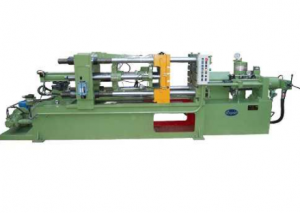There are several types of die casting machines in use today. Most of these machines are hydraulically actuated and operate horizontally, but vertically operating machines are also utilized. The principle difference between vertical and horizontal die casting machines is, as the terms imply, the direction of metal injection into the die.
All die casting machines include a metal injection system to get the metal in the die. A clamping system to keep the die halves closed during the injection. The two principal types of die casting machines are the hot chamber and cold chamber type. Next, we in-depth everything you need to know about Hot Chamber Machine and Cold Chamber Machine when it comes to die casting.

Hot Chamber Machine
The hot chamber machine is used mainly for die casting zinc and other metals of low melting temperature. However, it is also used to die-cast magnesium. The machine shot or charged end has a holding pot, which is a reservoir for the molten metal seated in a furnace. An injection system for transferring the metal through a gooseneck-shaped pipe to the die. The plunger end of the injection system and the lower portion of the transfer pipe are submerged in the molten metal.
For this reason, aluminum and copper alloys are unsuitable for use, since they chemically attack or erode the submerged injection system. When the plunger Rises, a charge of metal enters the pipe through a port. When the plunger descends it closes the port and drives the charge through a nozzle at the end of the pipe, and into the die. Injection pressures may range from 1,500 to more than 4,500 pounds per square inch, or ten to thirty one mega Pascal’s.
Cold Chamber Machine
The cold chamber machine is used primarily to die cast the aluminum, magnesium and copper alloys. In the cold chamber machine, the charge is supplied by a ladle or feed system from an external furnace source to a holding pot at the shot end of the machine. The feed system components are not submerged in molten metal. The charge is poured ahead of the plunger tip through a pour hole in the shot sleeve. As the plunger advances, it closes the pour hole and drives the molten metal into the die.
Injection pressures may range to 10,000 pounds per square inch or 69 mega Pascal’s for aluminum and magnesium. Although some machines can provide still greater pressures. After the metal in the die solidifies and the die halves are separating. The plunger thrusts forward extending the plunger tip past the cover die. This pushes the biscuit that solidifies at the end of the shot sleeve assisting casting release.
How Does Die Casting Machine Work
Dies are usually produced from hot work tool steels, mold steel, maraging steels and to a lesser extent refractory metals. Such as tungsten and molybdenum alloys. All tooling materials are noted for high hot strength and high temperature wear resistance. Dies are usually made by machining from blocks of wrought metal, but they also can be cast and machined. Because of their machined features precision and materials used. Die casting tooling is expensive but the dies are reusable for thousands or even hundreds of thousands of parts.
The covered die half contains a port for entry of the molten metal from the metal injection system. The ejector die half usually contains the channels called runners through which the molten metal flows to reach the gate or gates at the die cavity. Dies are typically single cavity or multiple cavities dies. Multiple cavity dies are usually used for multiple identical parts. However, they also can be used to produce parts of different designs and if so they are commonly called combination dies. Because such dies are often used to cast parts that will be assembled together. They are also called family dies meaning dyes for a family of parts.
Kors fixed or movable in either die half are used to cast holes in various directions. Fixed cores are in line with the direction in which the die haves open. Those four holes in other directions are retractable on moving slides also called core pools to move in and out with each shot. Inserts placed in position before each shot also can be used to cast complex features or to be cast in place as an integral casting feature.
To minimize porosity in the casting the die halves have vents to release the air that is pushed ahead of the metal shot. Overflow channels in the dye blocks catch surplus metal, they also assist in venting and provide locations of the casting for its ejection. Built into the die blocks are cooling lines. Circulating water or oil to dissipate the heat of the molten metal at a precise rate.
Cooling at a controllable coolant flow rate is important because it controls the metal solidification rate. An ejector system is required to release the casting. In the system, ejector pins are mounted between ejector plates in a pocket on the ejector side of the die. In most cases, they are activated by pneumatic or hydraulic cylinders. To facilitate casting ejection, dies and cores incorporate a slight draft or taper. The amount of the metal to be cast. In general, the lower the metals melting temperature, the less the draft required.